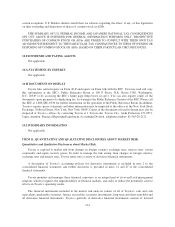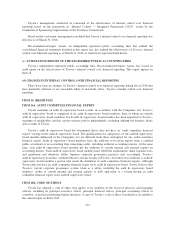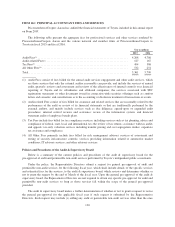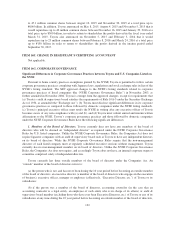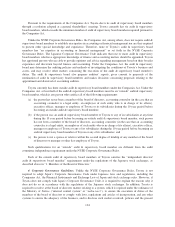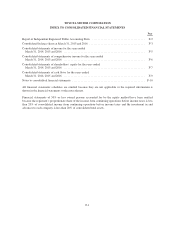Toyota 2015 Annual Report Download - page 138
Download and view the complete annual report
Please find page 138 of the 2015 Toyota annual report below. You can navigate through the pages in the report by either clicking on the pages listed below, or by using the keyword search tool below to find specific information within the annual report.such person who has not been an Executive Director, etc. of Toyota or any of its subsidiaries during the 10 year
period before becoming a member of the board of directors, accounting counselor or audit & supervisory board
member; and
(c) the person who is not a spouse or relative within the second degree of kinship of any member of the
board of directors or manager or other key employee of Toyota.
Such qualifications for an “outside” member of the board of directors are different from the director
independence requirements under the NYSE Corporate Governance Rules.
In addition, pursuant to the regulations of the Japanese stock exchanges, Toyota is required to have one or
more “independent director(s)/audit & supervisory board member(s),” defined under the relevant regulations of
the Japanese stock exchanges as “outside directors” or “outside audit & supervisory board members” (as defined
under the Companies Act), who are unlikely to have any conflicts of interests with Toyota’s general
shareholders, and is also required to make efforts to have at least one “independent director(s)/audit &
supervisory board member(s)” who is also a director. Each of the outside members of the board of directors of
Toyota satisfies the “independent director/audit & supervisory board member” requirements under the
regulations of the Japanese stock exchanges. Japan’s Corporate Governance Code provides that companies
should appoint at least two “independent outside directors” as defined based on the criteria for assessing director
independence established by Toyota in line with the independence standards of the Japanese stock exchanges.
The content of the criteria for assessing director independence established by Toyota is the same as that of the
independence standards of the Japanese stock exchanges, and each of the outside members of the board of
directors of Toyota satisfies the “independent outside director” requirements under such independence standards.
The definition of “independent director/audit & supervisory board member” and “independent outside director”
is different from that of the definition of independent director under the NYSE Corporate Governance Rules.
2. Committees. Under the Companies Act, Toyota has elected to structure its corporate governance system
as a company with audit & supervisory board members who are under a statutory duty to monitor, review and
report on the management of the affairs of Toyota. Toyota, as with other Japanese companies with an audit &
supervisory board, does not have certain committees that are required of U.S. listed companies subject to the
NYSE Corporate Governance Rules, including those that are responsible for director nomination, corporate
governance and executive compensation. However, members of Toyota’s “Executive Appointment Meeting” and
“Executive Compensation Meeting,” both consisting of the Chairman, President, Executive Vice President in
charge of human resources and an outside director, discuss recommendations to the board of directors concerning
nominees and remuneration for members of the board of directors, respectively.
Pursuant to the Companies Act, Toyota’s board of directors nominates and submits a proposal for the
appointment of members of the board of directors for shareholder approval. The shareholders vote on such
nomination at the general shareholders’ meeting. The Companies Act requires that the limits or calculation
formula and kind (in case that the remuneration, bonus and any other benefits in compensation for the execution
of duties (“remuneration, etc.”) are to be paid in other than cash) of remuneration, etc. to be paid to directors as
well as limits of remuneration, etc. to be paid to audit & supervisory board members must be determined by a
resolution of the general shareholders’ meeting, unless their remuneration, etc. is provided for in the articles of
incorporation. The distribution of remuneration, etc. among each member of the board of directors is broadly
delegated to the board of directors and the distribution of remuneration among each audit & supervisory board
member is determined by consultation among the audit & supervisory board members.
3. Audit Committee. Toyota avails itself of paragraph (c)(3) of Rule 10A-3 of the Exchange Act, which
provides a general exemption from the audit committee requirements to a foreign private issuer with an audit &
supervisory board, subject to certain requirements which continue to be applicable under Rule 10A-3.
133



